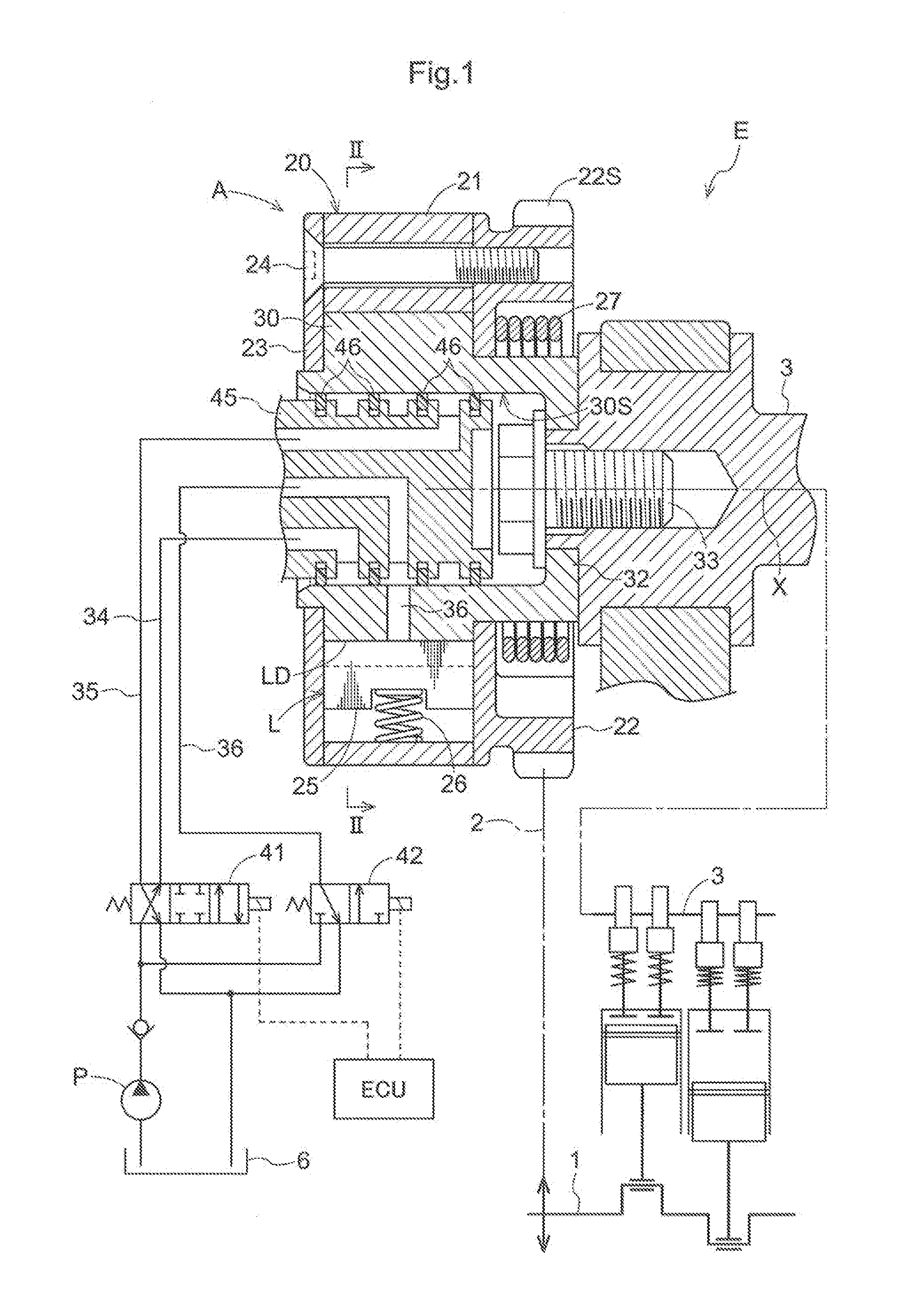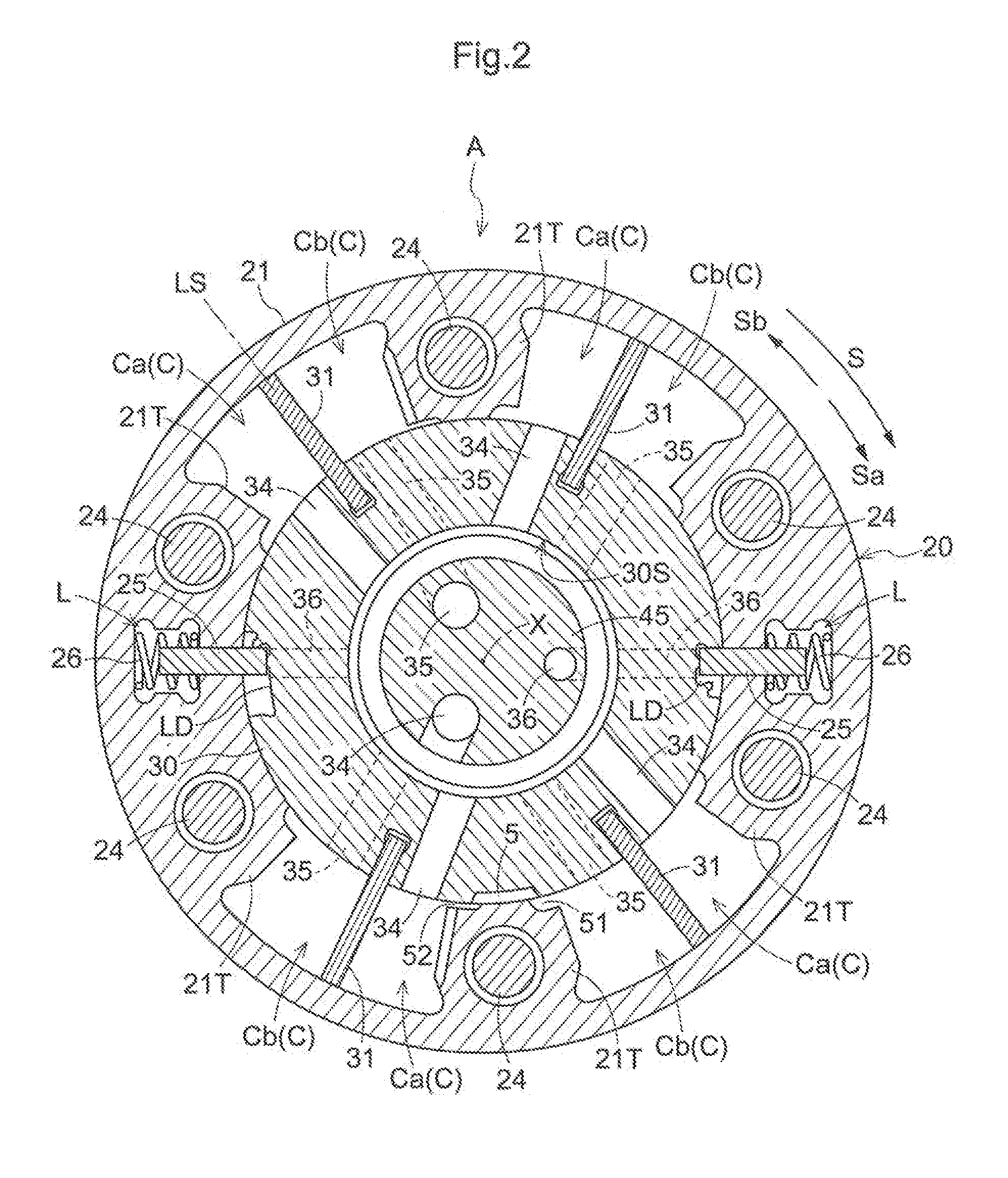Valve opening/closing timing control device
- Summary
- Abstract
- Description
- Claims
- Application Information
AI Technical Summary
Benefits of technology
Problems solved by technology
Method used
Image
Examples
first embodiment
1. First Embodiment
[0047]Next, a first embodiment of the disclosure will be explained with reference to the drawings.
[Basic Configuration]
[0048]FIG. 1 and FIG. 2 show a valve opening / closing timing control device A relating to the present disclosure. This valve opening / closing timing control device A includes an outer rotor 20 as a “drive-side rotating body”, an inner rotor 30 as a “driven-side rotating body”, and an intermediate lock mechanism L capable of being switched over between a locked state in which a relative rotational phase of the inner rotor 30 relative to the outer rotor 20 (this will be referred to as “relative rotational phase” hereinafter) is restrained to an intermediate lock phase LS between a most advanced angle phase and a most retarded angle phase, and an unlocked state in which the above restraint is released.
[0049]The outer rotor 20 includes a cylindrical rotor body 21 (an example of “outer circumferential wall portion”), a disc-like rear plate 22 (an example...
second embodiment
2. Second Embodiment
[0071]A second embodiment will now be explained regarding its differences from the first embodiment only, with reference to FIG. 7. Incidentally, for better understanding of the drawing, the following explanation will be made with denoting the same members as the first embodiment with the same reference marks / numerals.
[0072]In this embodiment, the communication passage 5 is formed by cutting out a portion of the outer rotor 20 which portion comes into opposition to the outer circumferential end face of the vane portion 31 under the locked state. This cutout can be formed at a corner portion or an inner face of the outer rotor 20. In this case, at the time of starting the engine E, with the effect of the centrifugal force associated with rotation of the outer rotor 20, the oil of the advance angle chamber Ca moves toward the outer circumferential side and at the same time it starts moving to the retard angle chamber Cb via the communication passage 5. Namely, the ...
third embodiment
3. Third Embodiment
[0073]A third embodiment will now be explained regarding its differences from the first embodiment only, with reference to FIG. 8. Incidentally, for better understanding of the drawing, the following explanation will be made with denoting the same members as the first embodiment with the same reference marks / numerals.
[0074]In this embodiment, the communication passage 5 is formed by cutting out a portion of one of the rear plate 22 and the front plate 23 to which portion the vane portion 31 under the locked state is projected in the direction of the rotational axis X. FIG. 8 shows the rear plate 22 with a portion thereof being cut out.
[0075]On the near side in the illustration, the advance angle chamber Ca is present and on the far side in the illustration across the vane portion 31, the retard angle chamber Cb is present. Namely, when the intermediate lock mechanism L is under the locked state, the communication passage 5 establishes communication between the adv...
PUM
 Login to View More
Login to View More Abstract
Description
Claims
Application Information
 Login to View More
Login to View More - R&D
- Intellectual Property
- Life Sciences
- Materials
- Tech Scout
- Unparalleled Data Quality
- Higher Quality Content
- 60% Fewer Hallucinations
Browse by: Latest US Patents, China's latest patents, Technical Efficacy Thesaurus, Application Domain, Technology Topic, Popular Technical Reports.
© 2025 PatSnap. All rights reserved.Legal|Privacy policy|Modern Slavery Act Transparency Statement|Sitemap|About US| Contact US: help@patsnap.com



